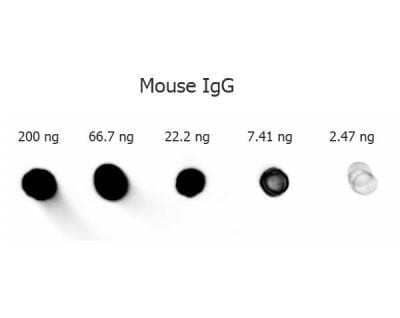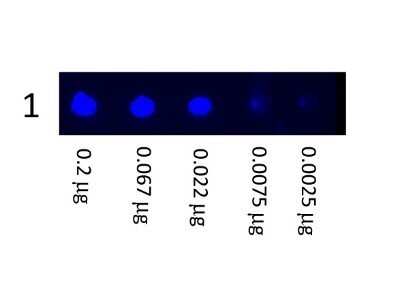Goat anti-Mouse IgG (H+L) Secondary Antibody (Pre-adsorbed)
Novus Biologicals, part of Bio-Techne | Catalog # NBP1-72739

![Western Blot: Goat anti-Mouse IgG (H+L) Secondary Antibody (Pre-adsorbed) [NBP1-72739] Western Blot: Goat anti-Mouse IgG (H+L) Secondary Antibody (Pre-adsorbed) [NBP1-72739]](https://resources.bio-techne.com/images/products/Goat-anti-Mouse-IgG-H+L-Secondary-Antibody-Pre-adsorbed-Western-Blot-NBP1-72739-img0005.jpg)
Conjugate
Catalog #
Forumulation
Catalog #
Key Product Details
Species Reactivity
Mouse
Applications
Chromatin Immunoprecipitation (ChIP), Dot Blot, ELISA, Immunocytochemistry/ Immunofluorescence, Immunohistochemistry, Immunohistochemistry-Frozen, Immunohistochemistry-Paraffin, Western Blot
Label
Unconjugated
Antibody Source
Polyclonal Goat IgG
Format
Pre-adsorbed
Concentration
Please see the vial label for concentration. If unlisted please contact technical services.
Product Specifications
Immunogen
Mouse IgG whole molecule
Specificity
This antibody was pre-adsorbed against Human Serum Proteins. No reaction was observed against Human Serum Proteins. Specificity was confirmed using ELISA at less than 1% cross reactivity against Human IgG.
Clonality
Polyclonal
Host
Goat
Isotype
IgG
Description
This product was prepared from monospecific antiserum by immunoaffinity chromatography using Mouse IgG coupled to agarose beads followed by solid phase adsorption(s) to remove any unwanted reactivities. Assay by immunoelectrophoresis resulted in a single precipitin arc against anti-Goat Serum, Mouse IgG and Mouse Serum
Store vial at 4C prior to opening. This product is stable for several weeks at 4C as an undiluted liquid. Dilute only prior to immediate use. For extended storage aliquot contents and freeze at -20C or below. Avoid cycles of freezing and thawing.
Store vial at 4C prior to opening. This product is stable for several weeks at 4C as an undiluted liquid. Dilute only prior to immediate use. For extended storage aliquot contents and freeze at -20C or below. Avoid cycles of freezing and thawing.
Scientific Data Images for Goat anti-Mouse IgG (H+L) Secondary Antibody (Pre-adsorbed)
Western Blot: Goat anti-Mouse IgG (H+L) Secondary Antibody (Pre-adsorbed) [NBP1-72739]
Western Blot: Goat anti-Mouse IgG (H+L) Secondary Antibody (Pre-adsorbed) [NBP1-72739] - 100 ug of Mouse IgG (Lane 2) was run on a 4-20% gel and transferred to 0.45 um nitrocellulose. After blocking with 1% BSA-TTBS 30 min at 20C, Antibody was used at 1:1000 in blocking buffer for Fluorescent Western blotting. Molecular weight markers are in lane 1. Image from the DyLight 488 version of this antibody.Immunocytochemistry/ Immunofluorescence: Goat anti-Mouse IgG (H+L) Secondary Antibody (Pre-adsorbed) [NBP1-72739]
Immunocytochemistry/Immunofluorescence: Goat anti-Mouse IgG (H+L) Secondary Antibody (Pre-adsorbed) [NBP1-72739] - DyLight and ATTO dye conjugated antibodies provide high signal and low background for confocal microscopy and high resolution Stimulated Emission Depletion (STED) Microscopy. Both Dylight and Atto conjugated secondary antibodies maintained robust, intense signal during repeated laser excitation and de-excitation used during STED microscopy. Shown here are: A. (Green) Mouse anti NuP (NuP=Nuclear Pore Protein) detected with Dylight 488 Goat anti mouse B. (Red) Rabbit Anti Ezh1/2 Pab (Ezh=enhancer of zeste homology) with detection by ATTO 425 conjugated Goat anti Rabbit C. (Red and Green) Images combined. Image from the DyLight 488 version of this antibody.Immunohistochemistry-Paraffin: Goat anti-Mouse IgG (H+L) Secondary Antibody (Pre-adsorbed) [NBP1-72739]
Immunohistochemistry-Paraffin: Goat anti-Mouse IgG (H+L) Secondary Antibody (Pre-adsorbed) [NBP1-72739] - Staining of paraffin embedded mouse tissue. Goat anti-Mouse DyLight 488 was used as a secondary antibody. Image from verified customer review. Image from the DyLight 488 version of this antibody.Applications for Goat anti-Mouse IgG (H+L) Secondary Antibody (Pre-adsorbed)
Application
Recommended Usage
ELISA
1:100000 - 1:500000
Immunohistochemistry
1:1000 - 1:6000
Immunohistochemistry-Frozen
1:5000 - 1:25000
Immunohistochemistry-Paraffin
1:5000 - 1:25000
Western Blot
1:3000 - 1:12000
Application Notes
This product has been tested by ELISA and is suitable for ELISA, western blot, and immunohistochemistry, as well as other assays requiring lot-to-lot consistency.
Formulation, Preparation, and Storage
Purification
Multi-step
Formulation
0.02 M Potassium Phosphate, 0.15 M Sodium Chloride, pH 7.2
Format
Pre-adsorbed
Preservative
0.01% Sodium Azide
Concentration
Please see the vial label for concentration. If unlisted please contact technical services.
Shipping
The product is shipped with polar packs. Upon receipt, store it immediately at the temperature recommended below.
Stability & Storage
Store at 4C short term. Aliquot and store at -20C long term. Avoid freeze-thaw cycles.
Background: IgG (H+L)
The 4 IgG subclasses, sharing 95% amino acid identity, include IgG1, IgG2, IgG3, and IgG4 for humans and IgG1, IgG2a, IgG2b, and IgG3 for mice. The relative abundance of each human subclass is 60% for IgG1, 32% for IgG2, 4% for IgG3, and 4% for IgG4. In an IgG deficiency, there may be a shortage of one or more subclasses (4).
References
1. Painter RH. (1998) Encyclopedia of Immunology (Second Edition). Elsevier. 1208-1211
2. Chapter 9 - Antibodies. (2012) Immunology for Pharmacy. Mosby 70-78
3. Schroeder H, Cavacini, L. (2010) Structure and Function of Immunoglobulins. J Allergy Clin Immunol. 125(2 0 2): S41-S52. PMID: 20176268
4. Vidarsson G, Dekkers G, Rispens T. (2014) IgG subclasses and allotypes: from structure to effector functions. Front Immunol. 5:520. PMID: 25368619
Additional IgG (H+L) Products
Product Documents for Goat anti-Mouse IgG (H+L) Secondary Antibody (Pre-adsorbed)
Product Specific Notices for Goat anti-Mouse IgG (H+L) Secondary Antibody (Pre-adsorbed)
This product is for research use only and is not approved for use in humans or in clinical diagnosis. Secondary Antibodies are guaranteed for 1 year from date of receipt.
Loading...
Loading...
Loading...
Loading...
![Immunocytochemistry/ Immunofluorescence: Goat anti-Mouse IgG (H+L) Secondary Antibody (Pre-adsorbed) [NBP1-72739] Immunocytochemistry/ Immunofluorescence: Goat anti-Mouse IgG (H+L) Secondary Antibody (Pre-adsorbed) [NBP1-72739]](https://resources.bio-techne.com/images/products/Goat-anti-Mouse-IgG-H+L-Secondary-Antibody-Pre-adsorbed-Immunocytochemistry-Immunofluorescence-NBP1-72739-img0002.jpg)
![Immunohistochemistry-Paraffin: Goat anti-Mouse IgG (H+L) Secondary Antibody (Pre-adsorbed) [NBP1-72739] Immunohistochemistry-Paraffin: Goat anti-Mouse IgG (H+L) Secondary Antibody (Pre-adsorbed) [NBP1-72739]](https://resources.bio-techne.com/images/products/Goat-anti-Mouse-IgG-H+L-Secondary-Antibody-Pre-adsorbed-Immunohistochemistry-Paraffin-NBP1-72739-img0004.jpg)
![Immunocytochemistry/ Immunofluorescence: Goat anti-Mouse IgG (H+L) Secondary Antibody (Pre-adsorbed) [NBP1-72739] Immunocytochemistry/ Immunofluorescence: Goat anti-Mouse IgG (H+L) Secondary Antibody (Pre-adsorbed) [NBP1-72739]](https://resources.bio-techne.com/images/products/Goat-anti-Mouse-IgG-H+L-Secondary-Antibody-Pre-adsorbed-Immunocytochemistry-Immunofluorescence-NBP1-72739-img0001.jpg)
![Immunohistochemistry-Frozen: Goat anti-Mouse IgG (H+L) Secondary Antibody (Pre-adsorbed) [NBP1-72739] Immunohistochemistry-Frozen: Goat anti-Mouse IgG (H+L) Secondary Antibody (Pre-adsorbed) [NBP1-72739]](https://resources.bio-techne.com/images/products/Goat-anti-Mouse-IgG-H+L-Secondary-Antibody-Pre-adsorbed-Immunohistochemistry-Frozen-NBP1-72739-img0003.jpg)


![ELISA: Goat anti-Mouse IgG (H+L) Secondary Antibody (Pre-adsorbed) [NBP1-72739] ELISA: Goat anti-Mouse IgG (H+L) Secondary Antibody (Pre-adsorbed) [NBP1-72739]](https://resources.bio-techne.com/images/products/Goat-anti-Mouse-IgG-H+L-Secondary-Antibody-Pre-adsorbed-ELISA-NBP1-72739-img0011.jpg)